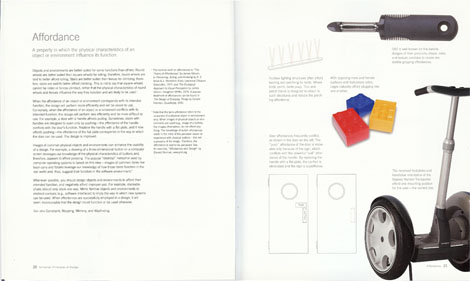Designers, want to refresh your foggy memories of the names of the theories you learned in design school? Product managers, engineers, and anyone else that works with a designer: want to understand the terms designers throw around? Then this is the book for you! Universal Principles of Design by William Lidwell, Kritina Holden, and Jill Butler is a cross-disciplinary design reference that defines and illustrates 100 design principles. A designer friend of mine recommended it to me a few years ago and it’s been a great reference ever since. The book’s subtitle is “100 ways to enhance usability, influence perception, increase appeal, make better design decisions, and teach through design.” As one of my favorite Food Network hosts Ina Garten says, “How bad could that be?”
It’s like a quick, introductory design class without the pop quizzes and annoying brown nosers. The book is organized alphabetically, making it easy to quickly reference a principle by name. Example principles are affordance, expectation effect, hierarchy, and rule of thirds. Each principle has a two-page spread. The spread’s first page describes the principle in layman’s terms and the second page shows real-world examples. Each principle has a “See also” section at the bottom which lists related principles.

Another cool feature is that table of contents is organized both alphabetically like the book, and also by category. The table of contents categories include “How can I influence the way a design is perceived?”, “How can I enhance the usability of a design?”, and “How can I make better design decisions?”

I find myself pulling this book off the shelf more often than almost any other book in my office. It’s easy to find the name of that theory that’s been bugging you. “Make it big to make it easier to click” sounds so much more professional when it’s called “Fitts’ Law.” (I know, I know. There’s more to Fitts’ Law than that. Here’s the book's definition: “The time required to move to a target is a function of the target size and distance to the target.”) The book is also a great source of examples of design principles in action. Every now and then I flip through it just for inspiration. The book is beautifully designed and a pleasure to look at. Enjoy!



